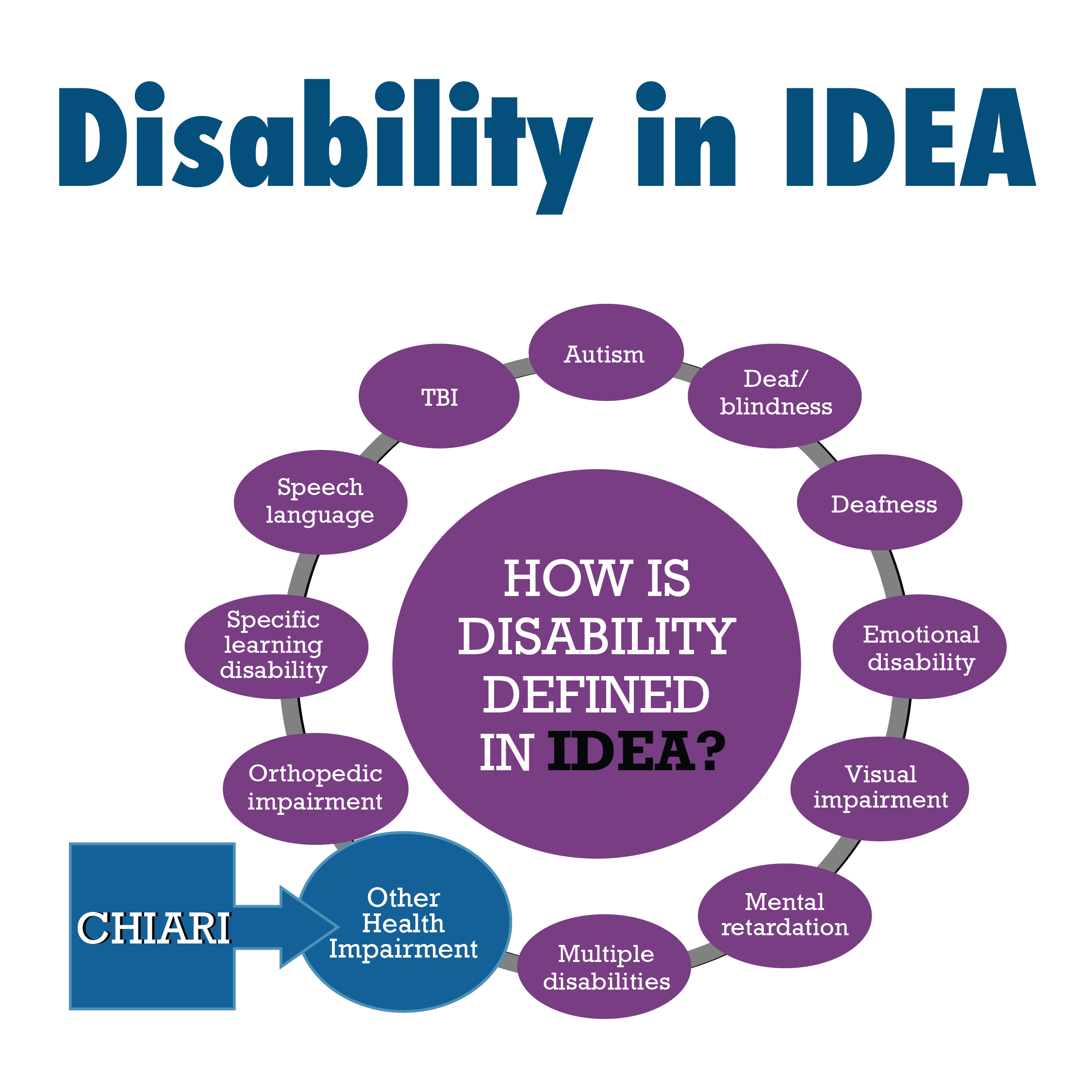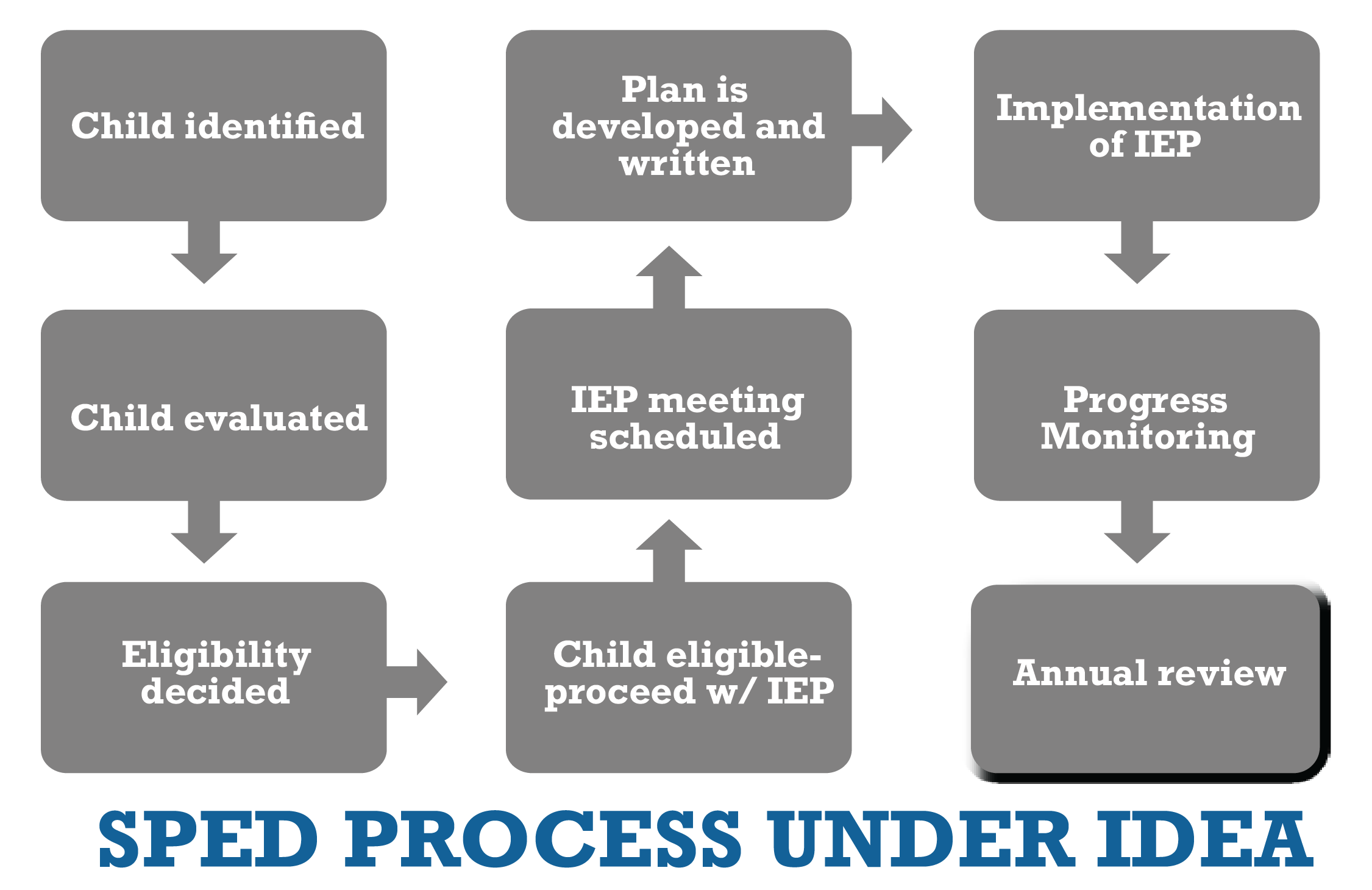

DISABILITY IN IDEA requires the student have a qualifying disability listed above and experiences a lack of academic progress requiring specialized instruction or services. SPED is an educational acronym used in the school setting. SPED represents special education. When a child is identified in the school setting who may benefit from and qualifies for an IEP the law dictates a very specific process with timeframes for completion. The process includes procedural safeguards to protect the child’s rights to Free Appropriate Public Education in the Least Restrictive Environment. Not all children with Chiari qualify for an IEP. Below is the SPED process under IDEA and outlined clearly by the National Dissemination Center for Children with Disabilities (2010).

Taking Chiari to School
For Parents
A positive parent-school relationship is critical when a child has a disability or health condition like Chiari. A collaborative approach, working with school staff to promote your child’s success, is in your child’s best interest. As a parent, your positive involvement at school and your relationship with the school affects your child’s cognitive, emotional, and behavioral performance at school. "Taking Chiari to School - A Parent's Guide" is intended to provide you with information to assist you as you navigate the school environment and help your child with Chiari succeed.
Taking Chiari to School - A Parent's Guide
Prepared by Suzanne Oró, RN, MSN-ed.
This guide is not intended to provide health or legal advice.
Copyright 2012 C&S Patient Education Foundation
For School Nurses
"Taking Chiari to School - A Primer for School Nurses" is for school nurses who may be responsible for the care of a child with the Chiari malformation type one (CM1). Chiari malformation type one (CM1), although not a common condition, may present challenges for the child in the school setting. Even though most children with CM1 are generally able to attend school with their peers, some require nursing care and accommodations in the school setting to promote their safety and success. Your familiarity with the CM1 diagnosis, symptoms, treatments, and available resources will reinforce parent efforts and provide continuity of care for the child with CM1 in school.
Taking Chiari to School - A Primer for School Nurses
Prepared by Suzanne Oró, RN, MSN-ed.
This guide is not intended to provide health or legal advice.
Copyright 2012 C&S Patient Education Foundation
What is an IEP?
An IEP is an individual education program. IEPs are for students with a qualifying disability under IDEA (see side) who require specialized instruction and services in the school setting to receive a free and appropriate public education in the least restrictive environment. The IEP, developed by a collaborative team, includes the school administrator, special services providers, general education teachers, special education teachers, the parents or guardians of the child, and the child. The IEP outlines the child’s present assessment information and abilities, the targeted and intense interventions and specialized instruction the child will receive, the goals of the IEP, and the accommodations the child requires to promote success. The IEP involves progress monitoring during the implementation of the IEP to track the child’s response to the interventions (National Dissemination Center for Children with Disabilities, 2010). The IEP is reviewed annually, upon parent request, during transitions to new schools, and if the child’s progress or lack of progress warrants a review of the IEP. Not all children with Chiari qualify for an IEP.
Laws that Affect the Education of Students
There are four primary laws that affect the education of children with disabilities or health impairments
Individuals with Disabilities in Education Act
The Individuals with Disabilities in Education Act (IDEA) requires public schools to make available to all eligible children with disabilities a free appropriate public education (FAPE) in the least restrictive environment (LRE) appropriate to their individual needs. A qualifying disability under IDEA provides your child with access to an evaluation for an Individual Education Program more commonly known as an IEP. The IDEA definition of disability is strictly defined and based upon the need for specialized educational instruction (Zirkel, 2009).
Americans with Disabilities Act (Amended, 2008).
The Americans with Disabilities Act (ADA) underwent revision and amendment in 2008 resulting in the Americans with Disabilities Act Amendment (ADAA). Significant changes included an expanded scope of the definition of major life activities, no longer considers mitigating measures, except vision correction, clarifies that the disability must be viewed within the frame of the impact of disease if it were fully active and cannot be discounted if it is episodic or in remission (Sampson & Galemore, 2012, United States Department of Education, 2009)
Section 504 of the Rehabilitation Act of 1973.
Section 504 of the Rehabilitation Act of 1973 states that qualified individuals with a disability will not be excluded from or discriminated against by any public institution or organization receiving federal funds. Section 504 of the Rehabilitation Act expands the definition of a disability into the following broad and simple definition: a disability is a mental or physical impairment that substantially limits one or more major life activities (United States Department of Education, 2009)
State Laws
Individual states set eligibility requirements and determine ages for services to children and youth with disabilities. Access to your state’s information can be located through your state’s Department of Education Office of Special Education.
This information can be accessed through the National Dissemination Center for Children with Disabilities at http://nichcy.org/state-organization-search-by-state